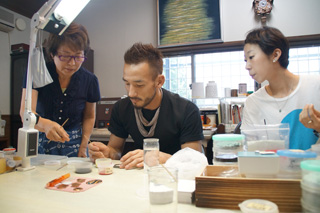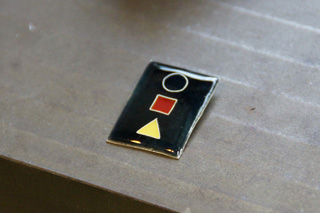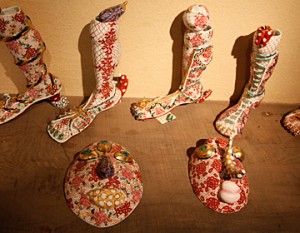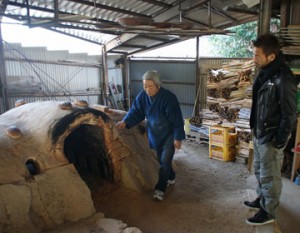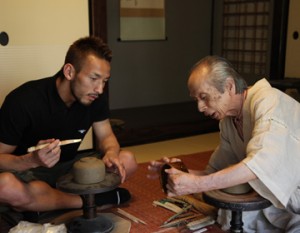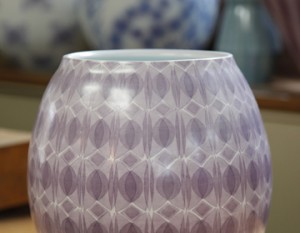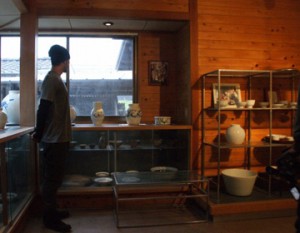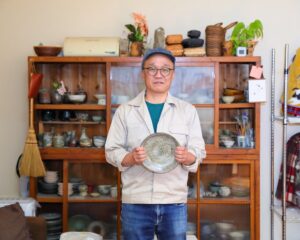The fusion of metal and glass
We saw many types of traditional ”kogei” in our travels, but this was our first encounter with cloisonné work. Cloisonné work is a craft made by baking a glassy glaze onto a silver or copper base. By baking the glaze, the glaze melts and shows colorful expressions. Cloisonné work is classified by whether the work has a base plate or wires, the transparency or the non-transparency of the glaze, etc.
Cloisonne work is from overseas
The technique originated in the middle east and transmitted to China through the silk road, and then reached Japan. One of the famous examples in Japan is the “Ruridenhai-no-juuni-ryoukyo” in Shoso in Nara. They were produced in quantity in the Meiji era, and many were exported overseas.
Presently, many people create cloisonné work as crafts as well as hobbies that can be created with home size electric ovens.
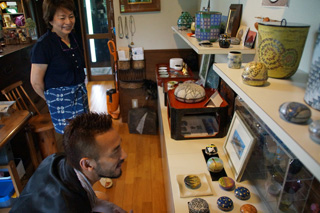
Meticulous work is the source of beauty.
What caught our eye at the workshop Nakata visited, was a small electric oven.
“So is this small oven good enough?”
“That’s the beauty of this type of craft. Yes there are some problems like not being able to bake many at a time, or needing a larger oven for larger objects.” answered Furuse the cloisonné artist. She is not only a cloisonné artist who participates in Nihon Kogeikai (literally Japan Crafts Association), but also holds classes for making 3-dimensional wire accessories, as well as teaching at the Tōhoku University of Art & Design.
As we entered her workshop, we were greeted by a display of her works. The pieces are colorful, and the smooth expression is very cute.
However, the glassy quality of the glaze, together with the metal give her work a classy impression. Her work is full of the charm of cloisonné.
She gave us an explanation of the work process, putting all the unfinished work in the order of the processes, like a teacher that she is. The process that she describes as “perhaps the most difficult task” is the process of assembling silver wires. The process involves drawing on the metal underneath and assembling the thin silver wires. Since the objects are not very big, the assembly is a very meticulous job to follow the original drawing. If it is not finished as per the drawing, the design of the glazing will not be in line. Her description of this job as being the most difficult task is totally understandable.
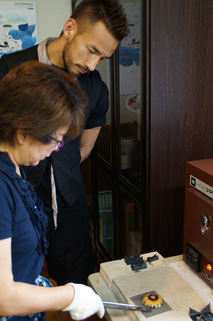
The shine of the glaze
The next task is placing the glaze. Nakata looked at her work and commented “All these colors come from the glaze, right? It’s amazing how you can paint them without the colors getting mixed. “To which Furuse answered as she showed Nakata the glaze, “It’s more like “placing” the colors instead of “painting them”. People mistakenly think that the glaze is liquid, but upon close observation, you can tell the particles are still there as particles, and so when using the glaze in cloisonné, it is, in fact, closer to use the expression “placing”.
When making small objects like pendants and brooches, even a slight slip of the hand will result in failure. It is a really meticulous work. Perhaps Nakata had not imagined that this work will be so difficult. 。
So Nakata also gave it a try. Furuse prepared some pendant heads with simple circle, triangle, and rectangle designs. When Nakata took the glaze into his hands, he was no longer the childlike person excited about what colors he should use. He had become silent as he concentrated on his hands. The task required his full concentration. Somehow managing to finish the glazing, he started baking. A few minutes later, his work was taken out of the oven and polished. Voila, the polished work was a completely different shade and shiny. It was all worth it for Nakata. The sheen of his work gives him great satisfaction. He exclaimed in satisfaction, “Boy I am happy!” and hung the result of his hard work around his neck.
